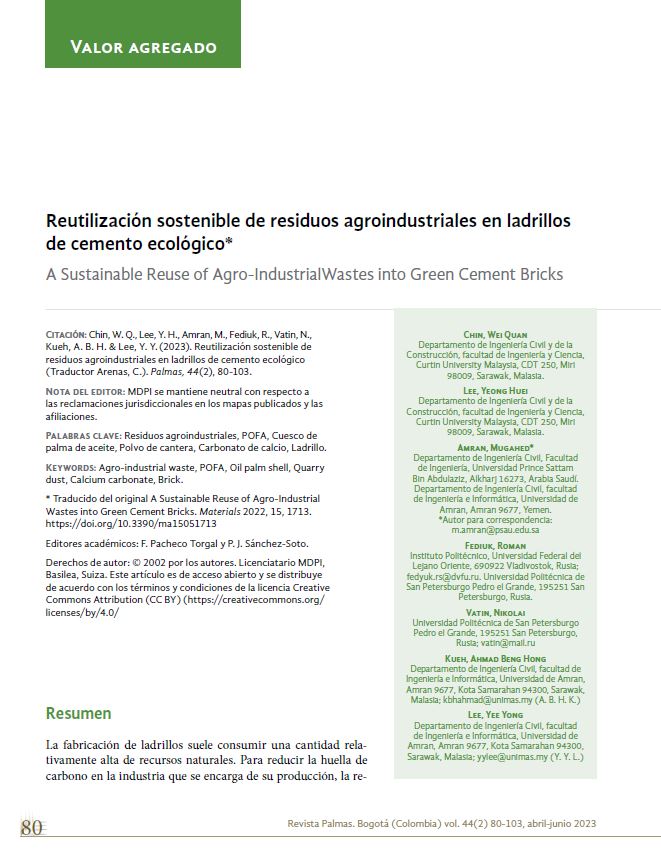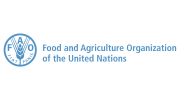Reutilización sostenible de residuos agroindustriales en ladrillos de cemento ecológico
Resumen
La fabricación de ladrillos suele consumir una cantidad relativamente alta de recursos naturales. Para reducir la huella de carbono en la industria de producción de ladrillos, la reutilización de residuos industriales en la fabricación de ladrillos sostenibles es una tendencia que se comenzó a investigar y aplicar recientemente. Año tras año, los países exportadores de aceite de palma producen grandes cantidades de residuos locales, como la cáscara de palma de aceite (OPS, por sus siglas en inglés), la ceniza de combustible de aceite de palma (POFA, por sus siglas en inglés) y el polvo de cantera (QD, por sus siglas en inglés). El QD de las industrias mineras también es peligroso para la calidad del agua del aire. Para una mejor gestión de los residuos en búsqueda de la sostenibilidad, estos residuos deben tener una segunda vida como materiales de construcción. Por lo tanto, este artículo investiga la posibilidad de incorporar residuos agroindustriales en la mezcla de ladrillos mediante el análisis de sus propiedades y realizando varias pruebas estandarizadas. Para el diseño de la mezcla se consideran experimentalmente un reemplazo del 100 % del agregado grueso con OPS, un reemplazo del 20 % del cemento con POFA, 20 % del peso de cemento de piedra caliza como mezcla y un reemplazo del 0 al 50 % del agregado fino con QD. La mezcla óptima de estos residuos se determina preliminarmente centrándose en la alta resistencia a la compresión como indicador. Otros análisis incluyen la resistencia a la rotura, la tracción y la flexión, la absorción de agua y las pruebas de eflorescencia. Aunque el ladrillo de cemento hecho con residuos agroindustriales tiene una relación de resistencia a peso 18 % más baja en comparación con el ladrillo convencional, se observa que tiene un mejor desarrollo de resistencia tardía debido a las propiedades puzolánicas de la POFA. Además, se verificó que el ladrillo de cemento ecológico propuesto cumpliera con varias normas para su uso viable en la industria de la construcción. En términos financieros, el costo del ladrillo con el nuevo diseño de mezcla es casi equivalente al del convencional. Por lo tanto, es razonable emplear este ladrillo de cemento ecológico en el sector de la construcción para promover la sostenibilidad de los materiales y mejorar la gestión de los residuos.
Referencias bibliográficas
Herbert, T. Brick: A world history. Choice Rev. Online 2004, 41, 3863. [CrossRef]
Zhang, L. Production of bricks from waste materials—A review. Constr. Build. Mater. 2013, 47, 643–655. [CrossRef]
Makul, N.; Fediuk, R.; Amran, H.M.M.; Zeyad, A.M.; de Azevedo, A.R.G.; Klyuev, S.; Vatin, N.; Karelina, M. Capacity to develop recycled aggregate concrete in South East Asia. Buildings 2021, 11, 234. [CrossRef]
Sebastián, E.; Cultrone, G. Technology of rammed-earth constructions (“Tapial”) in Andalusia (Spain): Their restoration and con- servation. In Materials, Technologies and Practice in Historic Heritage Structures; Dan, M.B., Prˇikry, R., Török, Á., Eds.; Springer: Dor- drecht, The Netherlands, 2010; pp. 11–28. ISBN 978-90-481-2684-2.
Balaguera, A.; Carvajal, G.I.; Albertí, J.; Fullana-i-Palmer, P. Life cycle assessment of road construction alternative materials: A literature review. Resour. Conserv. Recycl. 2018, 132, 37–48. [CrossRef]
Murmu, A.L.; Patel, A. Towards sustainable bricks production: An overview. Constr. Build. Mater. 2018, 165, 112–125. [CrossRef]
Mohd Hasan, M.R.; Chew, J.W.; Jamshidi, A.; Yang, X.; Hamzah, M.O. Review of sustainability, pretreatment, and engineering considerations of asphalt modifiers from the industrial solid wastes. J. Traffic Transp. Eng. 2019, 6, 209–244. [CrossRef]
Jong, L.Y.; Teo, D.C.L. Concrete containing palm oil fuel ash (POFA) and oil palm shell (OPS) subjected to elevated temperatures. J. Civ. Eng. Sci. Technol. 2014, 5, 13–17. [CrossRef]
Amran, M.; Fediuk, R.; Murali, G.; Vatin, N.; Karelina, M.; Ozbakkaloglu, T.; Krishna, R.S.; Kumar, A.S.; Kumar, D.S.; Mishra, J. Rice husk ash-based concrete composites: A critical review of their properties and applications. Crystals 2021, 11, 168. [CrossRef]
Avudaiappan, S.; Prakatanoju, S.; Amran, M.; Aepuru, R.; Saavedra Flores, E.I.; Das, R.; Gupta, R.; Fediuk, R.; Vatin, N. Experimental investigation and image processing to predict the properties of concrete with the addition of nano silica and rice husk ash. Crystals 2021, 11, 1230. [CrossRef]
Chiang, K.Y.; Chou, P.H.; Hua, C.R.; Chien, K.L.; Cheeseman, C. Lightweight bricks manufactured from water treatment sludge and rice husks. J. Hazard. Mater. 2009, 171, 76–82. [CrossRef]
Juel, M.A.I.; Mizan, A.; Ahmed, T. Sustainable use of tannery sludge in brick manufacturing in Bangladesh. Waste Manag. 2017, 60, 259–269. [CrossRef] [PubMed]
Kinuthia, J.M.; Nidzam, R.M. Towards zero industrial waste: Utilisation of brick dust waste in sustainable construction. Waste Manag. 2011, 31, 1867–1878. [CrossRef] [PubMed]
Ng, W.P.Q.; Lam, H.L.; Ng, F.Y.; Kamal, M.; Lim, J.H.E. Waste-to-wealth: Green potential from palm biomass in Malaysia. J. Clean. Prod. 2012, 34, 57–65. [CrossRef]
Asensio, E.; Medina, C.; Frías, M.; de Rojas, M.I.S. Characterization of ceramic-based construction and demolition waste: Use as pozzolan in cements. J. Am. Ceram. Soc. 2016, 99, 4121–4127. [CrossRef]
Muñoz, V.P.; Morales, O.M.P.; Letelier, G.V.; Mendívil, G.M.A. Fired clay bricks made by adding wastes: Assessment of the impact on physical, mechanical and thermal properties. Constr. Build. Mater. 2016, 125, 241–252. [CrossRef]
De Lassio, J.; França, J.; Espirito Santo, K.; Haddad, A. Case study: LCA methodology applied to materials management in a Brazilian residential construction site. J. Eng. 2016, 2016, 8513293. [CrossRef]
Kaza, S.; Yao, L.C.; Bhada-Tata, P.; Van Woerden, F. What a Waste 2.0: A Global Snapshot of Solid Waste Management to 2050; World Bank Publications: Washington, DC, EE. UU., 2018.
Arrigoni, A.; Grillet, A.C.; Pelosato, R.; Dotelli, G.; Beckett, C.T.S.; Woloszyn, M.; Ciancio, D. Reduction of rammed earth’s hygroscopic performance under stabilisation: An experimental investigation. Build. Environ. 2017, 115, 358–367. [CrossRef]
Sekhar, D.C.; Nayak, S. Utilization of granulated blast furnace slag and cement in the manufacture of compressed stabilized earth blocks. Constr. Build. Mater. 2018, 166, 531–536. [CrossRef]
Da Cardoso, A.C.F.; Galatto, S.L.; Guadagnin, M.R. Estimativa de geração de resíduos da construção civil e estudo de viabilidade de usina de triagem e reciclagem. Rev. Bras. Ciênc. Ambient. 2014, 31, 1–10.
Rodseth, C.; Notten, P.; von Blottnitz, H. A revised approach for estimating informally disposed domestic waste in rural versus urban South Africa and implications for waste management. S. Afr. J. Sci. 2020, 116, 1–6. [CrossRef]
Kadir, A.A.; Mohajerani, A. Bricks: An excellent building material for recycling wastes—A review. In Proceedings of the IASTED International Conference on Environmental Management and Engineering (EME 2011), Calgary, AB, Canada, 4–6 July 2011; pp. 108–115.
Al-Fakih, A.; Mohammed, B.S.; Wahab, M.M.A.; Liew, M.S.; Mugahed Amran, Y.H.; Alyousef, R.; Alabduljabbar, H. Characteristic compressive strength correlation of rubberized concrete interlocking masonry wall. Structures 2020, 26, 169–184. [CrossRef]
Lesovik, V.; Volodchenko, A.; Fediuk, R.; Mugahed Amran, Y.H.; Timokhin, R. Enhancing performances of clay masonry materials based on nanosize mine waste. Constr. Build. Mater. 2021, 269, 121333. [CrossRef]
Al-Fakih, A.; Mohammed, B.S.; Wahab, M.M.A.; Liew, M.S.; Mugahed Amran, Y.H. Flexural behavior of rubberized concrete interlocking masonry walls under out-of-plane load. Constr. Build. Mater. 2020, 263, 120661. [CrossRef]
Buyle, M.; Braet, J.; Audenaert, A. Life cycle assessment in the construction sector: A review. Renew. Sustain. Energy Rev. 2013, 26, 379–388. [CrossRef]
Smol, M.; Kulczycka, J.; Henclik, A.; Gorazda, K.; Wzorek, Z. The possible use of sewage sludge ash (SSA) in the construction industry as a way towards a circular economy. J. Clean. Prod. 2015, 95, 45–54. [CrossRef]
Raut, A.N.; Gomez, C.P. Development of thermally efficient fibre-based eco-friendly brick reusing locally available waste materials. Constr. Build. Mater. 2017, 133, 275–284. [CrossRef]
Lee, Y.H.; Amran, M.; Yong Lee, Y.; Hong Kueh, A.B.; Fui Kiew, S.; Fediuk, R.; Vatin, N.; Vasilev, Y. Thermal behavior and energy efficiency of modified concretes in the tropical climate: A systematic review. Sustainability 2021, 13, 11957. [CrossRef]
Tolstoy, A.; Lesovik, V.; Fediuk, R.; Amran, M.; Gunasekaran, M.; Vatin, N.; Vasilev, Y. Production of greener high-strength concrete using russian quartz sandstone mine waste aggregates. Materials 2020, 13, 5575. [CrossRef]
Da Silva, T.R.; de Azevedo, A.R.G.; Cecchin, D.; Marvila, M.T.; Amran, M.; Fediuk, R.; Vatin, N.; Karelina, M.; Klyuev, S.; Szelag, M. Application of plastic wastes in construction materials: A review using the concept of life-cycle assessment in the context of recent research for future perspectives. Materials 2021, 14, 3549. [CrossRef]
Lesovik, V.; Volodchenko, A.; Fediuk, R.; Mugahed Amran, Y.H. Improving the hardened properties of nonautoclaved silicate materials using nanodispersed mine waste. J. Mater. Civ. Eng. 2021, 33, 04021214. [CrossRef]
Petropavlovskii, K.; Novichenkova, T.; Petropavlovskaya, V.; Sulman, M.; Fediuk, R.; Amran, M. Faience waste for the production of wall products. Materials 2021, 14, 6677. [CrossRef] [PubMed]
De Carvalho Araújo, C.K.; Salvador, R.; Moro Piekarski, C.; Sokulski, C.C.; de Francisco, A.C.; de Carvalho Araújo Camargo, S.K. Circular economy practices on wood panels: A bibliographic analysis. Sustainability 2019, 11, 1057. [CrossRef]
Krishna, R.S.; Mishra, J.; Meher, S.; Das, S.K.; Mustakim, S.M.; Singh, S.K. Industrial solid waste management through sustainable green technology: Case study insights from steel and mining industry in Keonjhar, India. Mater. Today Proc. 2020, 33, 5243–5249. [CrossRef]
Ashour, T.; Korjenic, A.; Korjenic, S.; Wu, W. Thermal conductivity of unfired earth bricks reinforced by agricultural wastes with cement and gypsum. Energy Build. 2015, 104, 139–146. [CrossRef]
Yuan, X.; Tang, Y.; Li, Y.; Wang, Q.; Zuo, J.; Song, Z. Environmental and economic impacts assessment of concrete pavement brick and permeable brick production process—A case study in China. J. Clean. Prod. 2018, 171, 198–208. [CrossRef]
Shafigh, P.; Jumaat, M.Z.; Mahmud, H.B.; Hamid, N.A.A. Lightweight concrete made from crushed oil palm shell: Tensile strength and effect of initial curing on compressive strength. Constr. Build. Mater. 2012, 27, 252–258. [CrossRef]
Amran, M.; Murali, G.; Fediuk, R.; Vatin, N.; Vasilev, Y.; Abdelgader, H. Palm oil fuel ash-based eco-efficient concrete: A critical review of the short-term properties. Materials 2021, 14, 332. [CrossRef]
Mosaberpanah, M.A.; Amran, Y.H.M.; Akoush, A. Performance investigation of palm kernel shell ash in high strength concrete production. Comput. Concr. 2020, 26, 577–585. [CrossRef]
Al-Hokabi, A.; Hasan, M.; Amran, M.; Fediuk, R.; Vatin, N.I.; Klyuev, S. Improving the early properties of treated soft kaolin clay with palm oil fuel ash and gypsum. Sustainability 2021, 13, 910. [CrossRef]
Amran, M.; Lee, Y.H.; Fediuk, R.; Murali, G.; Mosaberpanah, M.A.; Ozbakkaloglu, T.; Lee, Y.Y.; Vatin, N.; Klyuev, S.; Karelia, M. Palm oil fuel ash-based eco-friendly concrete composite: A critical review of the long-term properties. Materials 2021, 14, 7074. [CrossRef]
Zeyad, A.M.; Johari, M.A.M.; Alharbi, Y.R.; Abadel, A.A.; Amran, Y.H.M.; Tayeh, B.A.; Abutaleb, A. Influence of steam curing regimes on the properties of ultrafine POFA-based high-strength green concrete. J. Build. Eng. 2021, 38, 102204. [CrossRef]
Teo, D.C.L.; Mannan, M.A.; Kurian, V.J. Structural concrete using oil palm shell (OPS) as lightweight aggregate. Turk. J. Eng. Environ. Sci. 2006, 30, 251–257.
Mannan, M.A.; Ganapathy, C. Engineering properties of concrete with oil palm shell as coarse aggregate. Constr. Build. Mater. 2002, 16, 29–34. [CrossRef]
Shafigh, P.; Jumaat, M.Z.; Mahmud, H. Oil palm shell as a lightweight aggregate for production high strength lightweight concrete. Constr. Build. Mater. 2011, 25, 1848–1853. [CrossRef]
Shafigh, P.; Johnson Alengaram, U.; Mahmud, H.B.; Jumaat, M.Z. Engineering properties of oil palm shell lightweight concrete containing fly ash. Mater. Des. 2013, 49, 613–621. [CrossRef]
Shafigh, P.; Jumaat, M.Z.; Mahmud, H. Mix design and mechanical properties of oil palm shell lightweight aggregate concrete: A review. Int. J. Phys. Sci. 2010, 5, 2127–2134.
Aslam, M.; Shafigh, P.; Jumaat, M.Z. Oil-palm by-products as lightweight aggregate in concrete mixture: A review. J. Clean. Prod. 2016, 126, 56–73. [CrossRef]
Zhao, Y.; Qiu, J.; Xing, J.; Sun, X. Recycling of quarry dust for supplementary cementitious materials in low carbon cement. Constr. Build. Mater. 2020, 237, 117608. [CrossRef]
Dhoka, M.M.C. Green concrete: Using industrial waste of marble powder, quarry dust and paper pulp. Int. J. Eng. Sci. Invent. 2013, 2, 67–70.
Lim, J.S.; Cheah, C.B.; Ramli, M.B. The setting behavior, mechanical properties and drying shrinkage of ternary blended concrete containing granite quarry dust and processed steel slag aggregate. Constr. Build. Mater. 2019, 215, 447–461. [CrossRef]
Irwan, J.M.; Othman, N.; Koh, H.B. Properties of sand cement brick containing quarry dust (SCBQD) and bacteria strain. Int. J. Sustain. Constr. Eng. Technol. 2020, 11, 13–22. [CrossRef]
Siddika, A.; Amin, M.R.; Rayhan, M.A.; Islam, M.S.; Mamun, M.A.A.; Alyousef, R.; Mugahed Amran, Y.H. Performance of sustainable green concrete incorporated with fly ash, rice husk ash, and stone dust. Acta Polytech. 2021, 61, 279–291. [CrossRef]
Saheed, S.; Amran, Y.H.M.; El-Zeadani, M.; Aziz, F.N.A.; Fediuk, R.; Alyousef, R.; Alabduljabbar, H. Structural behavior of out-of-plane loaded precast lightweight EPS-foam concrete C-shaped slabs. J. Build. Eng. 2021, 33, 101597. [CrossRef]
Saheed, S.; Aziz, F.N.A.A.; Amran, M.; Vatin, N.; Fediuk, R.; Ozbakkaloglu, T.; Murali, G.; Mosaberpanah, M.A. Structural performance of shear loaded precast EPS-foam concrete half-shaped slabs. Sustainability 2020, 12, 9679. [CrossRef]
Lim, S.K.; Tan, C.S.; Li, B.; Ling, T.C.; Hossain, M.U.; Poon, C.S. Utilizing high volumes quarry wastes in the production of lightweight foamed concrete. Constr. Build. Mater. 2017, 151, 441–448. [CrossRef]
Febin, G.K.; Abhirami, A.; Vineetha, A.K.; Manisha, V.; Ramkrishnan, R.; Sathyan, D.; Mini, K.M. Strength and durability properties of quarry dust powder incorporated concrete blocks. Constr. Build. Mater. 2019, 228, 116793. [CrossRef]
Ilangovana, R.; Mahendrana, N.; Nagamanib, K. Strength and durability properties of concrete containing quarry rock dust as fine aggregate. J. Eng. Appl. Sci. 2008, 3, 20–26.
Hamid Mir, A. Improved concrete properties using quarry dust as replacement for natural sand. Int. J. Eng. Res. Dev. 2015, 11, 46–52.
ASTM C330; Standard Specification for Lightweight Aggregates for Structural Concrete. ASTM International: West Conshohocken, PA, EE. UU., 2009. [CrossRef]
ASTM C33; Standard Specification for Concrete Aggregates. ASTM International: West Conshohocken, PA, EE. UU., 2010.
ASTM C143/C143M; Standard Test Method for Slump of Hydraulic-Cement Concrete. ASTM International: West Conshohocken, PA, EE. UU., 2015.
ASTM C172/C172M-10; Standard Practice for Sampling Freshly Mixed Concrete. ASTM International: West Conshohocken, PA, EE. UU., 2010.
ASTM C140/C140M; Standard Test Methods for Sampling and Testing Concrete Masonry Units and Related Units 1. ASTM International: West Conshohocken, PA, EE. UU., 2020.
ASTM C496/C496M-17; Standard Test Method for Splitting Tensile Strength of Cylindrical Concrete Specimens ASTM C-496. ASTM International: West Conshohocken, PA, EE. UU., 2011; ISBN 5919881100.
ASTM C78; Standard Test Method for Flexural Strength of Concrete. ASTM International: West Conshohocken, PA, EE. UU., 2016.
Sanders, J.P.; Brosnan, D.A. Test method for determining the efflorescence potential of masonry materials based on soluble salt content. J. ASTM Int. 2010, 7, 102725. [CrossRef]
Singh, M.; Siddique, R. Effect of coal bottom ash as partial replacement of sand on properties of concrete. Resour. Conserv. Recycl. 2013, 72, 20–32. [CrossRef]
Amran, M.; Fediuk, R.; Abdelgader, H.S.; Murali, G.; Ozbakkaloglu, T.; Lee, Y.H.; Lee, Y.Y. Fiber-reinforced alkali-activated concrete: A review. J. Build. Eng. 2022, 45, 103638. [CrossRef]
Muthusamy, K.; Nur Azzimah, Z. Exploratory study of palm oil fuel ash as partial cement replacement in oil palm shell lightweight aggregate concrete. Res. Appl. Sci. Eng. Technol. 2014, 8, 150–152. [CrossRef]
Uysal, M.; Yilmaz, K. Effect of mineral admixtures on properties of self-compacting concrete. Cem. Concr. Compos. 2011, 33, 771–776. [CrossRef]
Wang, D.; Shi, C.; Farzadnia, N.; Shi, Z.; Jia, H.; Ou, Z. A review on use of limestone powder in cement-based materials: Mechanism, hydration and microstructures. Constr. Build. Mater. 2018, 181, 659–672. [CrossRef]
Sargent, P. The development of alkali-activated mixtures for soil stabilisation. In Handbook of Alkali-Activated Cements, Mortars and Concretes; Elsevier: Amsterdam, The Netherlands, 2015; ISBN 9781782422884.
Alyousef, R.; Mohammadhosseini, H.; Alrshoudi, F.; Tahir, M.M.; Alabduljabbar, H.; Mohamed, A.M. Enhanced performance of concrete composites comprising waste metalised polypropylene fibres exposed to aggressive environments. Crystals 2020, 10, 696. [CrossRef]
Topçu, I.B.; Uygunogˇlu, T. Effect of aggregate type on properties of hardened self-consolidating lightweight concrete (SCLC). Constr. Build. Mater. 2010, 7, 1286–1295. [CrossRef]
Zhang, M.H.; Gjorv, O.E. Mechanical properties of high-strength lightweight concrete. ACI Mater. J. 1991, 88, 240–247. [CrossRef]
Babu, D.S.; Ganesh Babu, K.; Wee, T.H. Properties of lightweight expanded polystyrene aggregate concretes containing fly ash. Cem. Concr. Res. 2005, 35, 1218–1223. [CrossRef]
Shyam Prakash, K.; Rao, C.H. Study on compressive strength of quarry dust as fine aggregate in concrete. Adv. Civ. Eng. 2016, 2016, 1742769. [CrossRef]
Yew, M.K.; Bin Mahmud, H.; Ang, B.C.; Yew, M.C. Effects of oil palm shell coarse aggregate species on high strength lightweight concrete. Sci. World J. 2014, 2014, 387647. [CrossRef]
Aslam, M.; Shafigh, P.; Jumaat, M.Z. Drying shrinkage behaviour of structural lightweight aggregate concrete containing blended oil palm bio-products. J. Clean. Prod. 2016, 127, 183–194. [CrossRef]
Day, K.; Aldred, J.; Hudson, B. Properties of concrete. In Concrete Mix Design, Quality Control and Specification, 4th ed.; CRC Press: Boca Raton, FL, EE. UU., 2013.
Ismail, S.; Ramli, M. Mechanical strength and drying shrinkage properties of concrete containing treated coarse recycled concrete aggregates. Constr. Build. Mater. 2014, 68, 726–739. [CrossRef]
Al-Jabri, K.S.; Hisada, M.; Al-Saidy, A.H.; Al-Oraimi, S.K. Performance of high strength concrete made with copper slag as a fine aggregate. Constr. Build. Mater. 2009, 23, 2132–2140. [CrossRef]
Aliabdo, A.A.; Abd Elmoaty, A.E.M.; Fawzy, A.M. Experimental investigation on permeability indices and strength of modified pervious concrete with recycled concrete aggregate. Constr. Build. Mater. 2018, 193, 105–127. [CrossRef]
Tangchirapat, W.; Jaturapitakkul, C. Strength, drying shrinkage, and water permeability of concrete incorporating ground palm oil fuel ash. Cem. Concr. Compos. 2010, 32, 767–774. [CrossRef]
Lee, D.T.C.; Lee, T.S. The effect of aggregate condition during mixing on the mechanical properties of oil palm shell (OPS) concrete. In Proceedings of the MATEC Web of Conferences, Amsterdam, The Netherlands, 23–25 March 2016.
Lee, Y.H.; Chua, N.; Amran, M.; Lee, Y.Y.; Kueh, A.H.; Fediuk, R.; Vatin, N.; Vasilev, Y. Thermal performance of structural lightweight concrete composites for potential energy saving. Crystals 2021, 11, 461. [CrossRef]
Cómo citar
Descargas

Publicado
Número
Sección
Licencia
Derechos de autor 2023 Palmas

Esta obra está bajo una licencia internacional Creative Commons Atribución-NoComercial-SinDerivadas 4.0.












